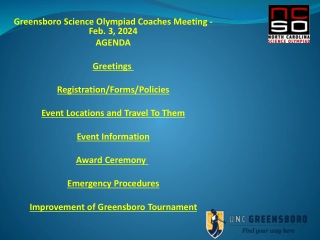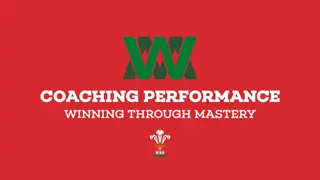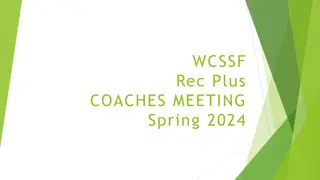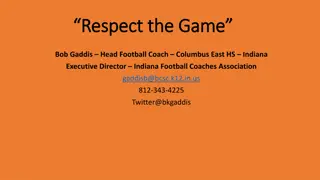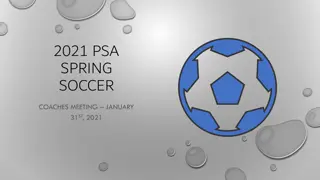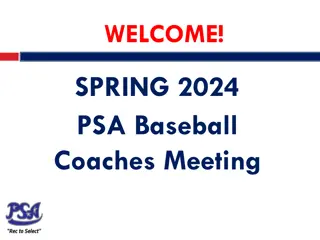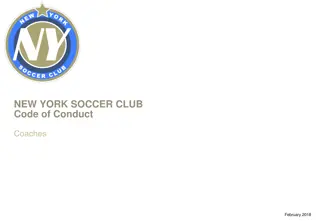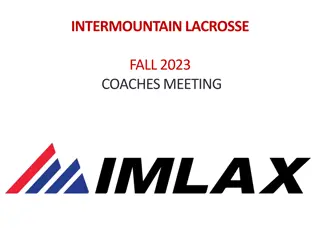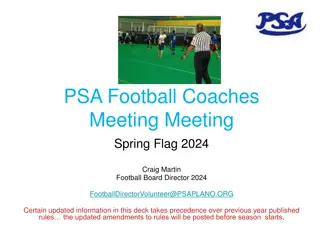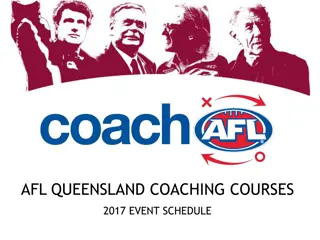
Title IX Training for Coaches
Title IX protects against sex discrimination in education programs receiving federal assistance, covering areas like sexual harassment, abuse, assault, and more. NCAA institutions must annually certify compliance with Title IX standards.
Download Presentation

Please find below an Image/Link to download the presentation.
The content on the website is provided AS IS for your information and personal use only. It may not be sold, licensed, or shared on other websites without obtaining consent from the author. If you encounter any issues during the download, it is possible that the publisher has removed the file from their server.
You are allowed to download the files provided on this website for personal or commercial use, subject to the condition that they are used lawfully. All files are the property of their respective owners.
The content on the website is provided AS IS for your information and personal use only. It may not be sold, licensed, or shared on other websites without obtaining consent from the author.
E N D
Presentation Transcript
Title IX and Coaching Staff Each year, the university President, the Athletic Director and the Title IX must make the following certifications to the NCAA for compliance: 1. The Athletics Department is informed on, integrated in, and compliant with institutional policies and processes regarding sexual violence prevention and proper adjudication and resolution of acts sexual misconduct. 2. The institutional policies and processes regarding sexual violence prevention and adjudication, the name and contact information for the campus Title IX Coordinator, are readily available to coaches, staff, and student athletes. 3. All student-athletes, coaches and staff have been educated each year on sexual violence prevention, intervention, and response.
What is Title IX? In simple terms, Title IX protects people from discrimination based on sex in education programs or activities that receive federal financial assistance. The scope of the Title IX office includes: Sexual Harassment Sexual Exploitation Non-consensual Sexual Contact Sexual assault / rape Dating / domestic Violence Stalking Sexual Misconduct Bullying (sex or sex stereotypes) Sex Discrimination
NCAA Campus Sexual Violence Policy Annual Attestation Policy training and compliance Dissemination of information Annual education for all student-athletes, coaches, and staff Prior conduct disclosure form for all prospective, continuing, and transfer student-athletes Prior conduct check Policy regarding gathering information from previous institution(s)
Title IX and Athletics Title IX requires an institution to: Provide equal opportunities for female and male students to become intercollegiate athletes Analyzed by means of a three-part test Proportionality: Opportunities for males and females substantially proportionate to their respective enrollment OR Program Expansion: Where one sex has been underrepresented, a history and continuing practice of program expansion responsive to the developing interests and abilities of that sex OR Full Accommodation: Where one sex is underrepresented and cannot show a continuing practice of program expansion, whether it can be demonstrated that the interests and abilities of that sex have been fully and effectively accommodated by that present program Provide equitable treatment of participants in the overall women s program as compared to the overall men s program
Title IX and Athletics Title IX DOES NOT require an institution to: Provide the same funding to the overall women s and men s programs Provide the same funding to men s and women s teams for the same sport Provide specific benefits to teams Offer the same number of teams for men and women Offer the same sports for men and women Provide the same benefits to men s and women s teams in the same sport Compete at a specific level
Equipment & Supplies Key factors in examining the equivalence for men and women: Quality of equipment and suppliers Amount of equipment and supplies Suitability of equipment and supplies Maintenance and replacement of the equipment and supplies Availability of equipment and supplies
Scheduling of Games and Practice Times Key factors in examining the equivalence for men and women: Number of competitive events per sport Number and length of practice opportunities Time of day competitive events are scheduled Time of day practice opportunities are scheduled Opportunities to engage in available pre-season and post- season competition
Travel and Per Diem Allowances Key factors in examining the equivalence for men and women: Modes of transportation Housing furnished during travel Length of stay before and after competitive events Per diem allowances Dining arrangements
Coaching Key factors in examining coaching: Opportunity to receive coaching Relative availability of full-time coaches Relative availability of part-time and assistant coaches Relative availability of graduate assistants Assignment of coaches Training, experience, and other professional qualifications Professional standing Compensation of coaches Rate of compensation (per sport, per season) Duration of contracts Conditions relating to contract renewal Experience Nature of coaching duties performed Working conditions Other terms and conditions of employment
Academic Tutoring Key factors in examining the equivalence for men and women: Academic Tutoring Availability of tutoring Procedures and criteria for obtaining tutorial assistance Assignment of Tutors Tutor qualifications Training, experience, and other qualifications Compensation of Tutors Hourly rate of payment by nature subjects tutored Pupil loads per tutoring season Tutor qualifications Experience Other terms and conditions of employment
Locker Rooms, Practice and Competitive Facilities Key factors in examining the equivalence for men and women: Quality and availability of the facilities provided for practice and competitive events Exclusivity of use of facilities provided for practice and competitive events Availability of locker rooms Quality of locker rooms Maintenance of practice and competitive facilities Preparation of facilities for practice and competitive events
Medical and Training Facilities and Services Key factors in examining the equivalence for men and women: Availability of medical personnel and assistance Health, accident, and injury insurance coverage Availability and quality of weight and training facilities Availability and quality of conditioning facilities Availability and qualifications of athletic trainers
Housing and Dining Facilities and Services Key factors in examining the equivalence for men and women: Housing provided Special services as part of housing arrangements (e.g., laundry facilities, parking space, cleaning service)
Publicity Key factors in examining the equivalence for men and women: Availability and quality of sports information personnel Access to other publicity resources for men's and women's programs Quantity and quality of publications and other promotional devices featuring men's and women's programs
Recruitment of Student Athletes Key factors in examining the equivalence for men and women: Whether coaches or other professional athletic personnel in the programs serving male and female athletes are provided with substantially equal opportunities to recruit Whether the financial and other resources made available for recruitment in male and female athletic programs are equivalently adequate to meet the needs of each program Whether the differences in benefits, opportunities, and treatment afforded prospective student athletes of each sex have a disproportionately limiting effect upon the recruitment of students of either sex
Support Services The administrative and clerical support provided to an athletic program can affect the overall provision of opportunity to male and female athletes, particularly to the extent that the provided services enable coaches to perform better their coaching functions. Key factors: Amount of administrative assistance provided to men's and women's programs Amount of secretarial and clerical assistance provided to men's and women's programs
NCAA & Sexual Violence The Executive Committee expects NCAA members to operate fairly and ethically, and further to assure that student-athletes are neither advantaged nor disadvantaged by special treatment and that institutions athletics departments must: Comply with campus authorities and ensure that all athletics staff, coaches, administrators and student-athletes maintain a hostile-free environment for all student-athletes regardless of gender or sexual orientation Know and follow campus protocol for reporting incidents of sexual violence Report immediately any suspected sexual violence to appropriate campus offices for investigation and adjudication
NCAA & Sexual Violence Educate all student-athletes, coaches, and staff about sexual violence prevention, intervention and response Assure compliance with all federal and applicable state regulations related to sexual violence prevention and response Cooperate with but not manage, direct, control, or interfere with college or university investigations into allegations of sexual violence ensuring that investigations involving student-athletes and athletics department staff are managed in the same manner as all other students and staff on campus
NCAA Policy on Campus Sexual Violence 1. The athletics department is informed on, integrated in, and compliant with institutional policies and processes regarding sexual violence prevention and proper adjudication and resolution of acts of sexual and interpersonal violence. 2. The institutional policies and processes regarding sexual violence prevention and adjudication, and the name and contact information for the campus Title IX Coordinator, are readily available within the department of athletics, and are provided to student-athletes.
NCAA Policy on Campus Sexual Violence 3. All student-athletes, coaches and staff have been educated each year on sexual violence prevention, intervention and response, to the extent allowable by state law and collective bargaining agreements. 4. All incoming, continuing and transfer student-athletes have completed an annual disclosure related to their conduct that resulted in discipline through a Title IX proceeding or in a criminal conviction for sexual, interpersonal or other acts of violence.* Transfer student-athletes also must disclose whether a Title IX proceeding was incomplete at the time of transfer. Failure to make a full and accurate disclosure could result in penalties, including loss of eligibility to participate in athletics as determined by the member institution.
NCAA Policy on Campus Sexual Violence *A person who has been disciplined through a Title IX proceeding or criminally convicted, regardless of the degree, and whether the result of a plea or court determination, of either of the following: Interpersonal Violence: Violence that is predominantly caused due to the relationship between the victim and the perpetrator, including dating and domestic violence. Sexual Violence: A term used to include both forcible and nonforcible sex offenses, ranging from sexual battery to rape. Other Acts of Violence: Crimes including murder, manslaughter, aggravated assault or any assault that employs the use of a deadly weapon or causes serious bodily injury.
NCAA Policy on Campus Sexual Violence 5. Institutions have taken reasonable steps to confirm whether incoming, continuing and transfer student athletes have been disciplined through a Title IX proceeding or criminally convicted of sexual, interpersonal or other acts of violence.** In a manner consistent with federal and state law, all NCAA member institutions must share relevant discipline information and incomplete Title IX proceedings as a result of transfer with other member institutions when a student-athlete attempts to enroll in a new college or university.
NCAA Policy on Campus Sexual Violence 6. An institution choosing to recruit an incoming student-athlete or accept a transfer student- athlete must have a written procedure that directs its staff to gather information that reasonably yields information from the former institution(s) to put the recruiting institutional leadership on notice that the student left the institution with an incomplete Title IX proceeding, was disciplined through a Title IX proceeding or has a criminal conviction for sexual, interpersonal or other acts of violence.* Failure to have it written and to gather information consistent with that procedure could result in penalties.
Understanding the Three Forms of Sexual Harassment
Institutional Obligations Under Title IX
NCAA Student-Athlete Education Requirements Healthy Relationships Consent Sexual violence prevalence Harassment Hazing & bullying Stalking Discrimination The role of alcohol and drug use in SV
Coaching and Communication Communication skills are needed to develop language that is not: Misogynistic Homophobic Demeaning Marginalizing Hostile Negative Don t tolerate bullying, demeaning or discriminating talk
Sexual Assault and Alcohol or Drug Use Alcohol was listed as a factor in more than 80% of sexual misconduct cases. Any person who is intoxicated or incapacitate in any way cannot give sexual consent. Alcohol use does not cause sexual assault, but it can be a major contributing factor. Sexual assaults involving alcohol more often occur among individuals who know each other casually as acquaintances, rather than among individuals in romantic relationships. Alcohol consumption is associated with aggression and loss of inhibition. Eliminating stigma around alcohol-involved sexual victimization is essential to support victims.
The Title IX Process Interim Measures Initial Assessment Intake OWAs evaluate for Title IX If not Title IX, referred to Student Engagement or HR Title IX or Conduct Informal Resolution Formal Investigation Title IX Formal or Informal Process
The Title IX Process Fact Finding Fair and transparent process Produces a report of finding Formal Investigation Panel of trained adjudicators Written Record or Live Hearing Preponderance of the evidence standard Adjudication Procedural error New evidence Conflict/Bias Appeal

